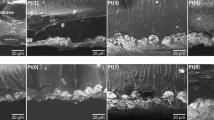Abstract
In this paper, we have designed and developed an ionic polymer metal composite (IPMC)-based artificial muscles by physical vapor deposition based fabrication technique. This process was used to avoid other costly and time-consuming fabrication methods. In the present study, gold electrode-based IPMC actuator chosen for its attractive properties, such as biocompatibility, low voltage-based actuation, and lightweight. A 17 × 1 mm2 rectangular strip of IPMC actuator used as a prototype for an active catheter-guidewire maneuvering application. Performance of the IPMC-based actuator examined through experimental and simulation results.












Similar content being viewed by others
References
Bhandari B, Lee GY, Ahn SH (2012) A review on IPMC material as actuators and sensors: fabrications, characteristics, and applications. Int J Precis Eng Manuf 13(1):141–163
Biswal DK, Bandopadhya D, Dwivedy SK (2011) Electro-mechanical and thermal characteristics of the silver-electroded ionic polymer–metal composite actuator. Proc Inst Mech Eng Part C J Mech Eng Sci 226(6):1427–1436
Carey J, Fahim A, Munro M (2004) Design of braided composite cardiovascular catheters based on required axial, flexural, and torsional rigidities. J Biomed Mater Res B Appl Biomater 70(1):73–81
De Gennes PG, Okumura K, Shahinpoor M, Kim KJ (2007) Mechanoelectric effects in ionic gels. Europhys Lett 50:513–518
Eisenberg A, Bailey FE (1986) Coulombic interactions in macromolecular systems. American Chemical Society, Washington, DC. https://doi.org/10.1021/bk-1986-0302
Fang BK, Ju MS, Lin CCK (2007) A new approach to develop ionic polymer–metal composites (IPMC) actuator: fabrication and control for active catheter systems. Sens Actuators A Phys 137(2):321–329
Gierke TD, Munn GE, Wilson FC (1982) Morphology of perfluorosulfonated membrane products (wise-angle and small-angle X-ray studies). Perfluorinated ionomer membranes ACS Series 180. Washington, DC, ACS
Guo S, Fukuda T, Nakamura T, Arai F, Oguro K, Negoro M (1996) Micro active guide wire catheter system characteristic evaluation, electrical model and operability evaluation of micro active catheter. Proc IEEE Int Conf Robot Autom 3:2226–2231
Mallavarapu K, Leo DJ (2001) Feedback control of the bending response of ionic polymer actuators. J Intell Mater Syst Struct 12(3):143–155
Marc Divoux GM (2012) Properties and performance of polymeric materials used in fuel cell applications. Ph.D. Dissertation, Virginia Polytechnic Institute and State University, pp 40–42
Nemat-Nasser S, Li JY (2000) Electromechanical response of ionic polymer–metal composites. J Appl Phys 87(7):3321–3331
Nemat-Nasser S, Wu Y (2003) Comparative experimental study of ionic polymer–metal composites with different backbone ionomers and in various cation forms. J Appl Phys 93(9):5255–5267
Pugal D (2012) Physics based model of ionic polymer–metal composite electromechanical and mechanoelectrical transduction. PhD Dissertation, UNR
Sadeghipour K, Salomon R, Neogi S (1992) Development of a novel electrochemically active membrane and ‘smart’ material based vibration sensor/damper. Smart Mater Struct 1(2):172–179
Shahinpoor M, Kim KJ (2004a) Ionic polymer–metal composites: IV. Industrial and medical applications. Smart Mater Struct 14(1):197–214
Shahinpoor M, Kim KJ (2004b) Ionic polymer–metal composites: III. Modeling and simulation as biomimetic sensors, actuators, transducers, and artificial muscles. Smart Mater Struct 13(6):1362–1388
Siripong M, Fredholm S, Nguyen Q, Shih B, Itescu J, Stolk J (2005) A cost-effective fabrication method for ionic polymer-metal composites. MRS Proc 889. https://doi.org/10.1557/PROC-0889-W04-03
Sugino T, Kiyohara K, Takeuchi I, Mukai K, Asaka K (2009) Actuator properties of the complexes composed by carbon nanotube and ionic liquid: the effects of additives. Sens Actuators B Chem 141(1):179–186
Tadokoro S, Yamagami S, Takamori T, Oguro K (2000) Modeling of Nafion–Pt composite actuators (ICPF) by ionic motion. Proc SPIE 3987:92–102
Takenaka H, Torikai E, Kawami Y, Wakabayashi N (1982) Solid polymer electrolyte water electrolysis. Int J Hydrog Energy 7(5):397–403
Tiwari R, Garcia E (2011) The state of understanding of ionic polymer metal composite architecture: a review. Smart Mater Struct 20(8):083001
Tondu B (2015) What is an artificial muscle? A systemic approach. Actuators 4(4):336–352
Wang Y, Bachman M, Li G-P, Guo S, Wong BJF, Chen Z (2005) Low-voltage polymer-based scanning cantilever for in vivo optical coherence tomography. Opt Lett 30(1):53–55
Acknowledgements
The authors would like to acknowledge the Microelectronics Lab and Central Research Facility (CRF) of the Indian Institute of Technology, Kharagpur for providing fabrication and characterization facilities.
Author information
Authors and Affiliations
Corresponding author
Additional information
Publisher's Note
Springer Nature remains neutral with regard to jurisdictional claims in published maps and institutional affiliations.
Rights and permissions
About this article
Cite this article
Tripathi, A.S., Chattopadhyay, B.P. & Das, S. Cost-effective fabrication of ionic polymer based artificial muscles for catheter-guidewire maneuvering application. Microsyst Technol 25, 1129–1136 (2019). https://doi.org/10.1007/s00542-018-4152-3
Received:
Accepted:
Published:
Issue Date:
DOI: https://doi.org/10.1007/s00542-018-4152-3




